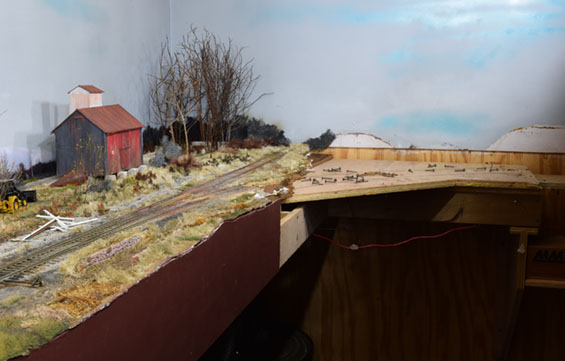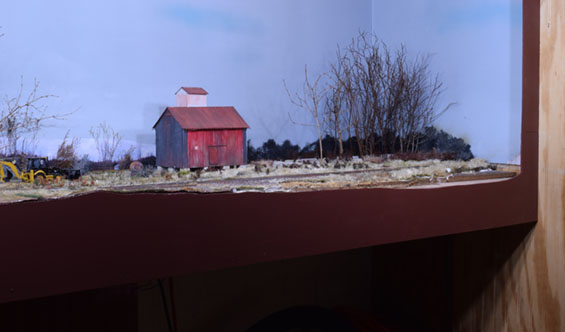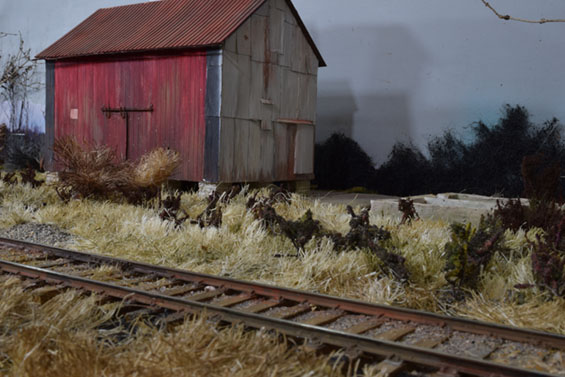I have written often of my frustration with the one and only curve on the layout. A 48 inch radius is too tight for a standard gauge curve in quarter-inch scale even in a branchline setting. While my equipment would operate through it, the cars and especially the locomotive looked ridiculous. The curve also had super elevation, so certain cars would lean in toward the center and derail because the wheels lifted off the outside rail.
I pondered a lot of different ideas but in the end, none of them were satisfying. There is simply not enough room to increase the radius without a major rebuild that would involve half of the layout. Furthermore, I realized that I tended to avoid running on this track, which prompted me to question if I’m not going to use the track, why have it in the first place?
In thinking long and hard about the curve, the one option I kept coming back to was removing this section of the layout completely. Why would I reduce the size of the layout, since this track allowed a train to leave the modeled scene? Keep reading.
Think of what you will gain instead of what you might lose
While considering the removal of this area, I thought in terms of what I would gain instead of what would be lost. The gains revolved around an opportunity to focus my evolving vision of the layout more tightly. Think of it as editing a manuscript, anything that doesn’t directly contribute to the story needs to go.
Even though the curve was faithful to the track arrangement of Valley Junction, my rendition of it was a visual caricature. The toy-train nature of how rolling stock looked on it was at odds with the realism I worked so hard to achieve elsewhere on the layout. The character of the tight radius didn’t mesh with the flowing lines of the No. 10 turnouts or the quality of the scenery. By removing this curve, I eliminated the visual mis-match and emphasized the realism of the rest of the layout by bringing a greater degree of consistency to everything.
Focus is a principle I think I understand better than I actually do.
My temptation from the beginning of this layout was to include too many elements under the guise of following the prototype. Quarter-inch scale doesn’t suffer this kind of foolishness for long before the compromises involved exert their toy-like influence.
Over the years I realized that overcrowding is a prime reason why quarter-inch scale suffers in appearance when compared to smaller scales. The volumetric increase in the size of everything in this scale automatically eats up the empty space in a given area and, it’s this empty space that is critical to realism of a scene. One of the keys to the effectiveness of the mill scene in the photo above is the openness and breathing room it has. The empty space around the track and the mill provides the breathing room we expect to see and, by eliminating the visual crowding so typical of modeled scenes, you are free to focus more intently on what is included.
Focus On Operations
This is all well and good but, what about the impact on operations of removing the curve and staging cassette?
This is a concern. That’s why it took me so long to work up the courage to make the change, I wasn’t sure if having the train captive so to speak, would ruin things. I don’t think that has to be a foregone conclusion though, because it depends on your objectives for operating. Mine have grown far simpler.
I have never been enthralled with the idea of multi-person operating sessions. Having to depend on others to fully enjoy my layout seems counterintuitive at best. My preference has always been for impromptu, relaxed operations whenever the mood hits. Therefore, I’m very content to switch a handful of cars for a few minutes, then call it a day.
Understanding what I most enjoy about operations, allows me to focus on what I would gain with the changes, such as a more intense focus on the sequence of steps the ground man has to perform and his interactions with the locomotive. This is more interesting to me than any over the road running. At this point, I don’t know if the inability to have a train leave the modeled scene will be satisfying or not. That’s something I will determine over the course of time as I adjust to the current changes.
I think focus matters more than size.
Many of us bemoan the lack of the space for the layout we desire. It’s understandable given the emphasis on large layouts driven by operation-oriented criteria like multiple towns or the perceived distances required for timetable & train orders or other operating styles. If your space is truly limited or you don’t follow the mainstream, it’s easy to feel left out of the party. I’m actually of the opposite mind in preferring a much smaller layout as a deliberate choice.
What I find interesting now is applying different design principles to the layout to see how far I can carry things. I treat it as a canvas to express my impressions of the full-size world and whether or not I make further changes is still uncertain. For now I’m happier with things and I don’t miss the curve at all. In fact I’m glad to have that monkey off my back. As you can see in the next to last photo, I have some ground cover to fill in and I need to decommission the former junction turnout but otherwise, the change as I envisioned it is complete.
It’s easy to feel deprived if you can’t have as big a layout as you’d like and the criteria I use aren’t to everyone’s taste but, I hope there is something useful for others in my ongoing experience with the I&W. I have discovered that a layout of any size is rewarding when it matches your objectives and expectations. Perhaps that’s the real key to satisfaction in this craft.
Regards,
Mike




Hi Mike,
I think ridding yourself of the tight curve is an essential piece of “The Missing Conversation”. Tight curves are an element that allow the “empire” to fit the basement but at the same time destroy the illusion of realism everytime a train is present. The other aspect you didn’t mention, is that when you’re working to finescale standards it’s much harder to get things to function reliably when you’ve pushed the envelope beyond prototype dimensions. Like you I had to learn the hard way and rip out handlaid track to regain realism and reliability because I had a similarly tight curve in P87. I find myself in total agreement with you about downsizing to regain realism, reliability and satisfaction.
regards,
Nigel
Mike, I believe you have made a difficult but wise decision. I have been, more and more, of the “less is more” camp for some time now and this will be reflected in the layout that my friend Mark Hill and I are building. I had already established the size of the modules (this is a portable effort) at 3′ by 5′ before Mark came on board and when it came time to work out a track arrangement we opted to pull the main line to one edge as opposed the the conventional module idea of down the middle. This will allow the surrounding scenes to over shadow the trains to a greater extent and offer maximum space for captivating vignettes. It is our intention to lure modellers to O and possibly P-48. We have settled on a minimum radii of 72″ and this will be on scene for any industrial track and the interchange curve and then one day some off scene track at the ends to curve to some staging.
So, after that selfish bit of rambling, I am sure you will gain more from the visual than you may have lost in function.
Bravo, David
Mike,
Once you have switched the train and it is ready to depart, then for you the operational interest is effectively over. If you were watching a play, then maybe the train would exit stage right, but the stage lights might go down instead, and you would not see the actors leaving the scene. In a movie or a TV show, this is evn more likely to be the case.
I am sure that the new, reduced, arrangement will be sufficiently satisfying for you.
Simon
Hi Nigel,
I’m no longer convinced that tightening up on curve radius is ever a good idea. Unless it’s an industrial track or interurban, the trade-off in appearance isn’t worth the operating headaches. I’m glad I removed the track and after a week, I don’t miss it at all.
Good to hear from you. Thanks for commenting.
Regards,
Mike
Hi David,
Thanks for the encouragement. Your modular efforts sound interesting. P48 is always in need of well-done examples to show people what’s possible. You might find the upcoming posts for the next two weeks interesting and applicable to your work, so stay tuned. Thanks for commenting.
Regards,
Mike
Hi Simon,
Astute observation. It isn’t that I don’t enjoy over-the-road running, just that I have so little room for it. Given that situation, I decided that switching would give a greater return in the space I have and the amount of layout I desire.
I love your analogy of the lights fading to black. I’m in the process of experimenting to see if I need some sense of the train coming from or going to somewhere else. I mocked up a possible solution the other night and quickly discovered I don’t enjoy running into a hidden staging area where I can’t see the train’s progress. I can say with conviction I prefer staging that is visible but unobtrusive.
Good to hear from you as always and thanks for commenting.
Regards,
Mike
Mike,
The right decision, and an excellent observation of the crowding effect in the larger scales. I think one issue for most modelers is they want to build something, get the trains running, and have this massive operating session once a month. One of the first steps in design for the modeler is how often do I want to “operate” my model and what type of operations do I want to pursue. People tend to forget what drew them to the hobby. Maybe it was watching an older first generation switcher working a local industry. Maybe a photo of a passenger train being put together at a station. They need to be honest with themselves and build a manageable project that ultimately will be enjoyable to them and remind them of what first drew them to the hobby.
As Simon points out so well, if done well, a model railroad is like watching a play. It’s operation has characters, various acts and if large, even a scene change. If more people took their true interest, not what the market says would be your interest, more people would build something that when complete wouldn’t bore them, requiring a change and starting all over again.
Enjoy never hearing the squeal of steel wheels against a tight curve!! Your ears, if only in your imagination, will love you.
Matt
Hi Matt,
It’s frightfully easy to lose sight of what drew us into the craft. I still find myself wondering just how minimal can a layout be and still be interesting. It’s so tempting to include “just one more feature” for the sake of operating interest. Those were my thoughts at the beginning of this layout, however, I’ve discovered that far fewer features are needed and it’s been eye opening.
Good to hear from you Matt. Thanks for commenting.
Regards,
Mike